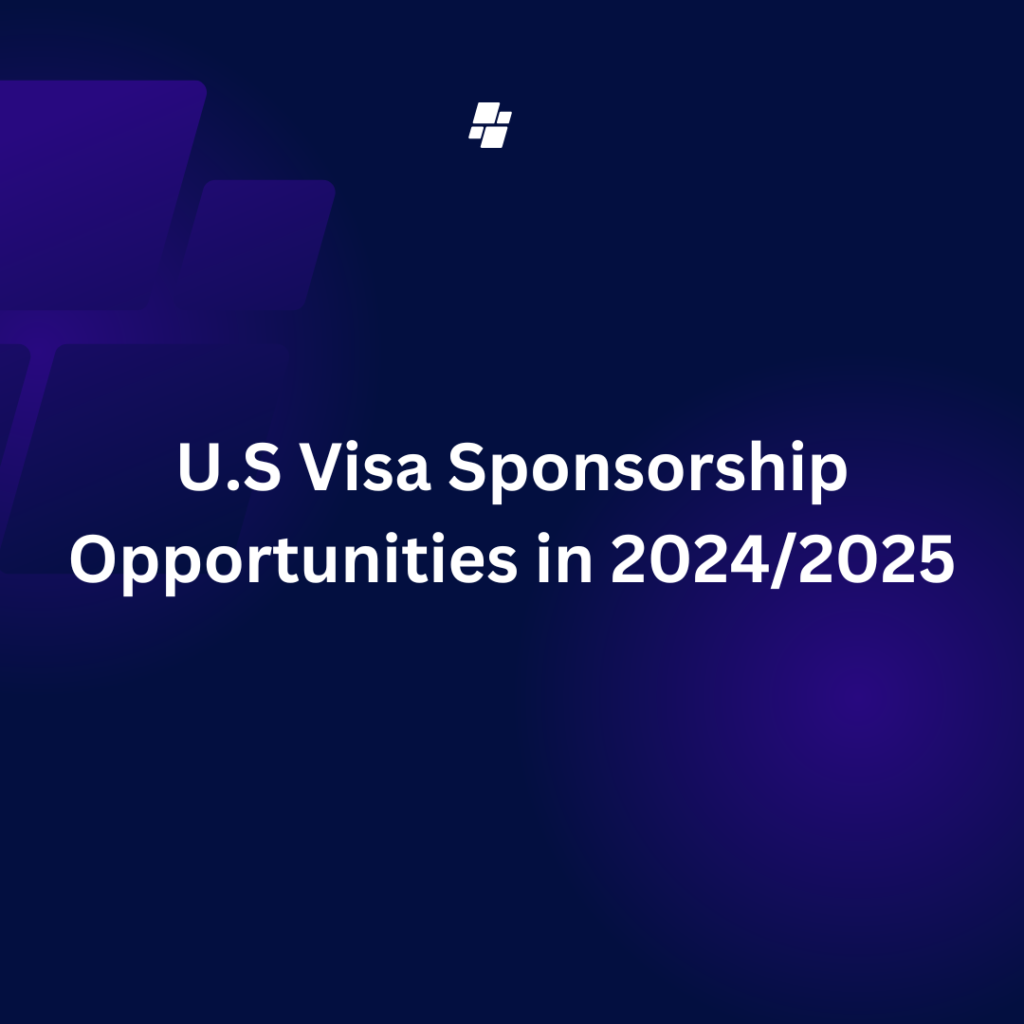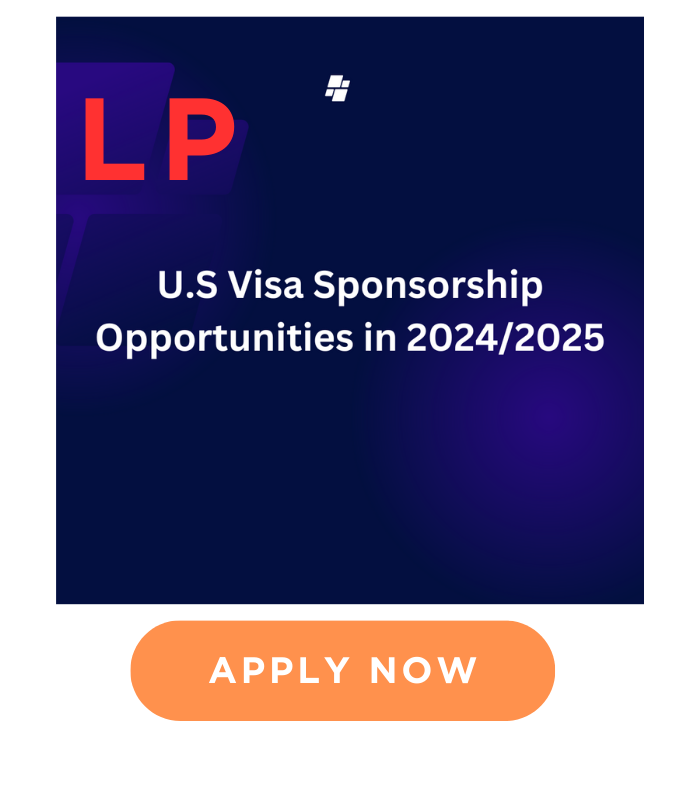
U.S Visa Sponsorship Opportunities in 2024/2025
Do you possess valuable skills and dream of working and living in the dynamic landscape of the United States? Are you aiming for a specific career path but concerned that the salary might not meet visa sponsorship criteria? Worry no more, aspiring professionals! This comprehensive guide delves into the vast landscape of U.S. visa sponsorship opportunities. IN 2024/2025
We will navigate the sponsorship process, explore career paths that offer sponsorship, and equip you with valuable resources to launch your journey toward achieving the American dream. Let’s explore how your skills can pave the way for a promising future in the U.S.!
Who Can Sponsor You for a U.S. Visa?
Sponsorship for U.S. visas generally falls into two primary categories based on the type of visa:
Employment-Based Visas
1. U.S. Employers: This is the most common pathway for employment-based. U.S. companies can petition for foreign workers to fill specific job roles, provided they demonstrate that no suitable U.S. citizen or permanent resident is available for the position.
Family-Based Visas
2. U.S. Citizens or Permanent Residents: U.S. citizens and green card holders can sponsor family members such as spouses, parents, unmarried children under 21, and sometimes siblings.
Breakdown of Visa by Type
H-1B Visas (Specialty Occupations):
- Eligible Sponsors: U.S. employers hiring for roles that require specialized knowledge and at least a bachelor’s degree.
EB-2 Visas (Advanced Degrees or Exceptional Ability):
- Eligible Sponsors: U.S. employers for individuals with advanced degrees (Master’s or Ph.D.) or exceptional abilities in fields like science, arts, or business.
EB-3 Visas (Skilled Workers, Professionals, and Other Workers):
- Eligible Sponsors: U.S. employers for skilled workers with a minimum of two years of training, professionals with a bachelor’s degree, or unskilled workers for jobs experiencing labor shortages.
L Visas (Intra-Company Transfers):
- Eligible Sponsors: U.S. companies sponsoring current international employees to transfer to a U.S. branch in managerial or specialized positions.
E Visas (Treaty Traders and Investors):
- Eligible Sponsors: Available for citizens of countries with a commerce treaty with the U.S. and involve trade or substantial investment in a U.S. business.
Key Considerations
- Not all U.S. employers provide. Research companies that have a history of sponsoring foreign workers.
- Sponsorship can be complex, with specific requirements for both the employer and the applicant.
- Legal assistance is recommended. Consulting with an immigration attorney can help navigate the process and improve your chances of success.
How to Apply for U.S. Visa Opportunities in 2024/2025
Types of Sponsor
- Employment-Based Sponsorships: U.S. employers sponsor foreign workers for specific job roles.
- Family-Based Sponsorships: U.S. citizens or permanent residents sponsor certain family members.
Focus on Employment-Based Sponsorships: While obtaining sponsorship can be challenging, it’s not impossible. Here’s what you should know:
- Target Industries with Sponsorship Potential:
- Research sectors experiencing labor shortages. Industries like healthcare, IT, and social services often have a higher likelihood of sponsorship. The U.S. Department of Labor (DOL) website provides data on in-demand occupations.
2. Explore Visa Categories:
- Understand different visas like H-1B for specialized jobs or EB-3 for skilled and unskilled workers. Familiarity with each category’s requirements helps tailor your job search.
3. Enhance Your Skills:
- Ensure your skills match the demands of your target job. Consider obtaining certifications or additional training to boost your profile.
4. Create a Strong Resume and Cover Letter
- Highlight relevant accomplishments. Customize your resume to reflect the specific job and quantify your achievements with data.
5. Strategic Networking:
- Attend industry events and job fairs, and use platforms like LinkedIn to connect with potential employers and recruiters.
Additional Tips for Success
Internal Company Transfers:
If you work for a multinational with U.S. offices, inquire about internal transfer opportunities to secure an L visa.
Consult an Immigration Attorney:
Seeking advice from an attorney specializing in employment-based sponsorships can streamline the process and improve your chances.
Sponsorship Options and Their Processes
H-1B Visa (Specialty Occupations):
- Employer Requirement: The employer must prove the position requires specialized skills and cannot be filled by a U.S. worker.
- Salary: Must meet the prevailing wage for the specific occupation.
EB-3 Visa (Skilled and Unskilled Workers):
- Sponsorship Criteria: Employers must show they were unable to find a qualified U.S. worker.
- Common Roles: Includes positions like healthcare assistants, construction workers, and restaurant managers.
L Visa (Intra-Company Transfer):
- Eligibility: For employees who have worked for the company for at least one year within the past three years.
Resources for Finding Sponsorship Opportunities
Employer Websites:
Many companies post job openings with potential sponsorship on their careers pages. Look for mentions of visa sponsorship or relocation assistance.
Job Boards:
Platforms like Indeed and Glassdoor offer job listings that indicate visa sponsorship.
Government Resources:
The U.S. Department of Labor (DOL) website provides information on occupations with labor shortages, helping you target industries with higher sponsorship potential.
Consult with Professionals:
An immigration attorney can help determine the best visa options and guide you through the complex sponsorship process.
Tips for Securing U.S. Visa Sponsorship
1. Highlight Your Skills:
- Align your qualifications with the needs of the job. Consider further training if needed to make your profile stand out.
2. Showcase Achievements:
- Create a compelling resume that quantifies your accomplishments and demonstrates your contributions.
3. Build a Strong Network:
- Engage with professionals in your field and attend industry-specific events to increase visibility.
4. Be Open to Additional Options:
- Consider high-investment options like the EB-5 visa, which provides a path to a green card for investors who create jobs in the U.S.
EB-3 Visa Sponsorship Jobs and Salaries for 2024
EB-3 Subcategories:
- Unskilled Workers: Positions requiring less than two years of training.
- Skilled Workers: Jobs that need at least two years of experience but not necessarily a degree.
- Professionals: Roles requiring a bachelor’s degree.
Job Examples and Salaries:
- Healthcare: Medical Assistants ($36,910), Licensed Practical Nurses ($48,210), Physical Therapist Assistants ($62,430).
- Social Services: Social Workers ($49,100), Childcare Workers ($25,180).
- Technical Fields: Network Administrators ($82,570), Carpenters ($49,540), Welders ($41,740).
Finding EB-3 Sponsorship Opportunities
Employer Sites: Check company career pages for sponsorship details.
Job Boards: Visit job sites like Indeed and Glassdoor for sponsored positions.
Government Resources: Use the DOL website to identify in-demand roles.
Consult an Immigration Attorney: Professional guidance can make navigating the EB-3 process more manageable.
Salary Considerations
Employers must prove that they offered the prevailing wage for the position, demonstrating that no qualified U.S. worker was available at that salary. You can find this data on the DOL site or through your employer’s PERM certification.
